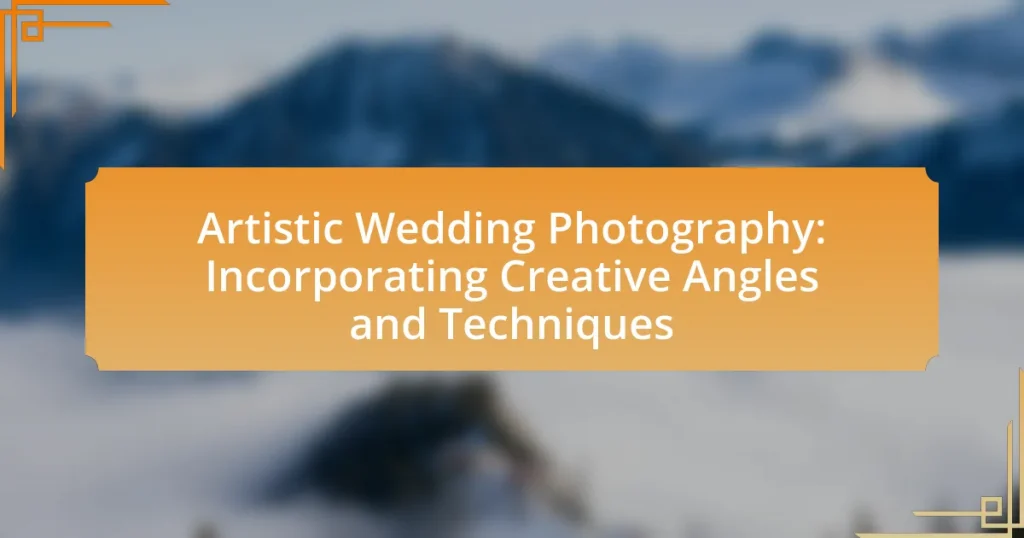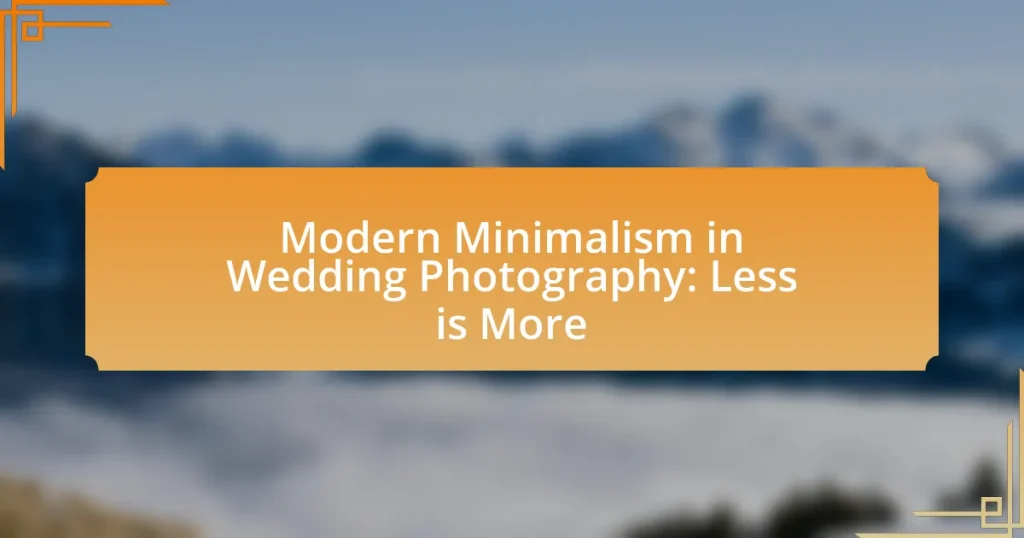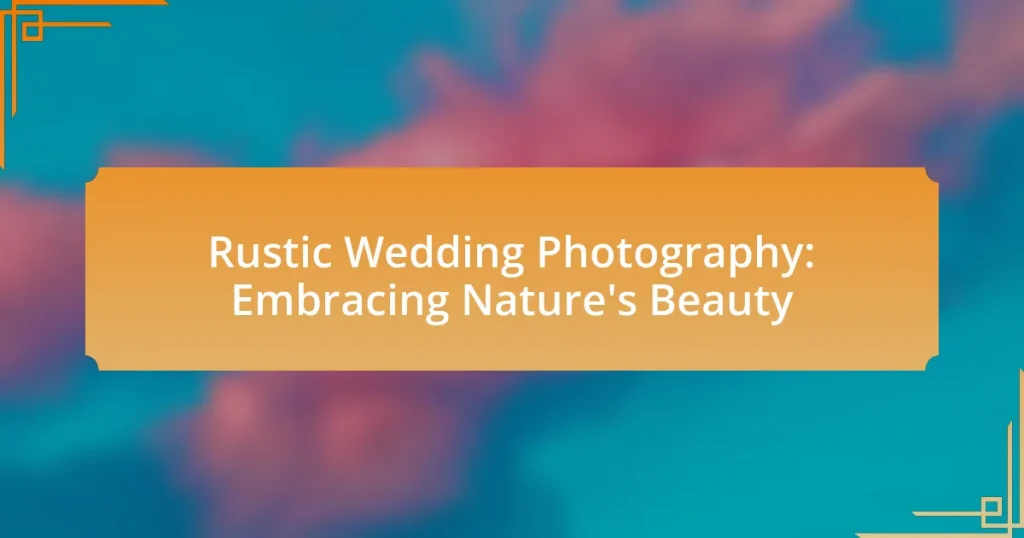Artistic wedding photography is a creative style that prioritizes emotional storytelling and unique compositions, distinguishing itself from traditional photography through innovative angles and techniques. This article explores the defining elements of artistic wedding photography, including the importance of lighting, composition, and the use of unconventional perspectives to enhance visual narratives. It also discusses the emotional value of capturing genuine moments, the role of post-processing, and best practices for photographers in planning and executing artistic shoots. Additionally, the article highlights how couples can collaborate with photographers to achieve their desired vision, ensuring that their wedding memories are captured in a compelling and personalized manner.
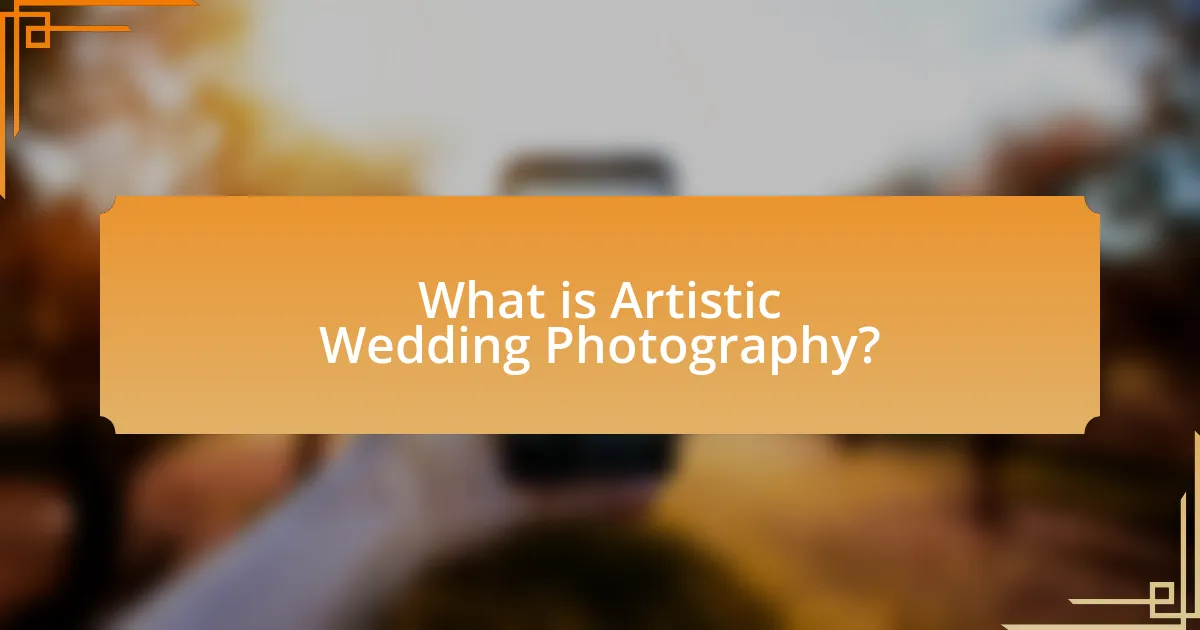
What is Artistic Wedding Photography?
Artistic wedding photography is a style that emphasizes creativity and artistic expression in capturing wedding moments. This approach often involves unique angles, innovative compositions, and the use of natural light to create visually striking images that tell a story. Photographers specializing in this genre typically focus on the emotional aspects of the day, aiming to evoke feelings through their imagery. The use of techniques such as dramatic lighting, unconventional framing, and candid shots enhances the artistic quality of the photographs, making them more than just documentation of the event.
How does Artistic Wedding Photography differ from traditional photography?
Artistic wedding photography differs from traditional photography primarily in its emphasis on creativity and storytelling through unique compositions and techniques. While traditional photography often focuses on posed, formal shots and standard framing, artistic wedding photography incorporates unconventional angles, dramatic lighting, and candid moments to capture the emotional essence of the event. This approach allows for a more personalized narrative, showcasing the couple’s personality and the atmosphere of the day, rather than adhering strictly to conventional norms.
What unique elements define Artistic Wedding Photography?
Artistic Wedding Photography is defined by its emphasis on creativity, composition, and emotional storytelling. This style utilizes unique angles, dramatic lighting, and artistic framing to capture moments in a visually compelling way. For instance, photographers often incorporate unconventional perspectives, such as aerial shots or close-ups, to create a narrative that reflects the couple’s personality and the atmosphere of the event. Additionally, the use of post-processing techniques enhances the artistic quality, allowing for a distinct aesthetic that sets it apart from traditional wedding photography.
How does the approach to composition vary in Artistic Wedding Photography?
The approach to composition in Artistic Wedding Photography emphasizes creativity and emotional storytelling, differing from traditional methods that focus primarily on posed shots. Artistic photographers often utilize unconventional angles, asymmetrical framing, and dynamic perspectives to capture candid moments, enhancing the narrative of the wedding day. For instance, they may shoot from above or below the subjects, creating a more engaging visual experience. This technique not only highlights the couple’s emotions but also incorporates the surrounding environment, making the composition more immersive. Studies have shown that unique compositions can evoke stronger emotional responses from viewers, reinforcing the importance of innovative approaches in this genre.
Why is Artistic Wedding Photography important for couples?
Artistic wedding photography is important for couples because it captures the unique essence and emotions of their special day in a visually compelling manner. This style of photography employs creative angles and techniques that transform ordinary moments into extraordinary visual narratives, allowing couples to relive their wedding day through stunning imagery. Research indicates that couples who invest in artistic photography often report higher satisfaction with their wedding memories, as these images evoke deeper emotional connections and tell a more personalized story compared to traditional photography.
What emotional value does Artistic Wedding Photography provide?
Artistic Wedding Photography provides a profound emotional value by capturing genuine moments and feelings that reflect the couple’s unique love story. This style of photography emphasizes creativity and artistic expression, allowing for images that evoke nostalgia, joy, and intimacy. Research indicates that couples often cherish photographs that not only document their wedding day but also convey the emotions experienced during those moments, enhancing their connection to the event. By utilizing creative angles and techniques, artistic wedding photography transforms ordinary scenes into extraordinary memories, reinforcing the emotional significance of the day.
How can Artistic Wedding Photography enhance the storytelling of a wedding day?
Artistic wedding photography enhances the storytelling of a wedding day by capturing emotions, moments, and details in a visually compelling manner. This style employs creative angles, unique compositions, and artistic techniques to convey the narrative of the day, allowing viewers to experience the event as if they were present. For instance, using techniques like depth of field can emphasize the couple’s expressions while blurring the background, drawing attention to their emotional connection. Additionally, candid shots taken from unconventional perspectives can reveal genuine interactions among guests, enriching the overall story. Studies show that visual storytelling significantly impacts memory retention, making artistic photography an effective tool for preserving the essence of the wedding day.
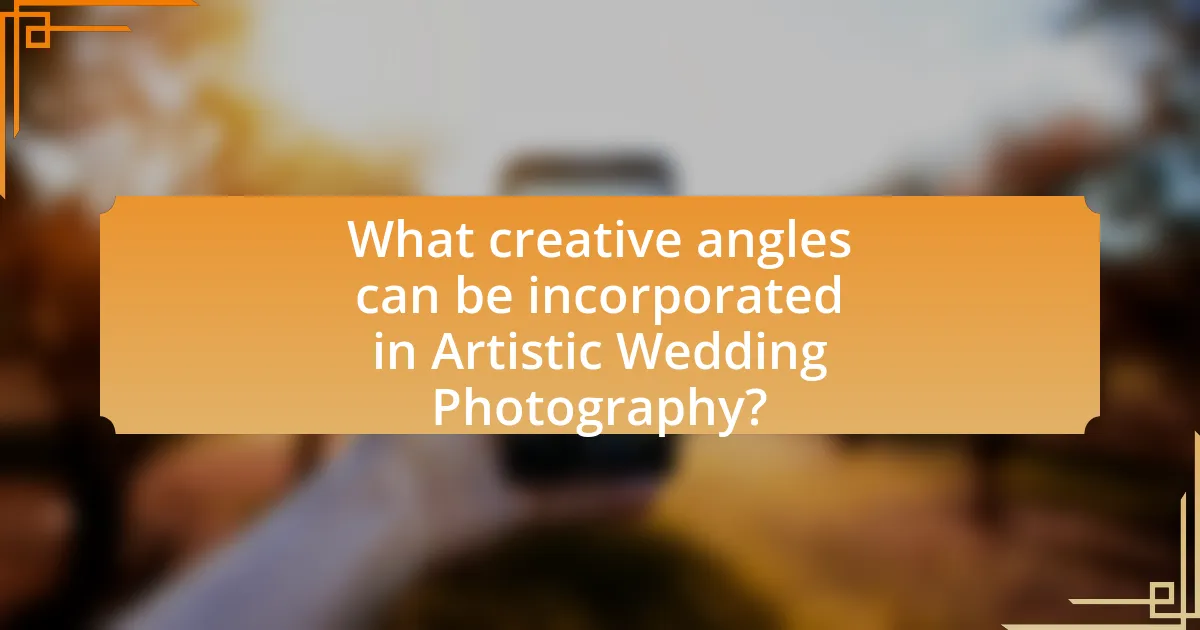
What creative angles can be incorporated in Artistic Wedding Photography?
Creative angles in artistic wedding photography include aerial shots, low-angle perspectives, and close-up details. Aerial shots capture the venue and guests from above, providing a unique overview that emphasizes the scale and setting of the event. Low-angle perspectives can enhance the grandeur of the couple or venue, making subjects appear more imposing and dramatic. Close-up details focus on elements like rings, flowers, or textures, adding intimacy and depth to the narrative. These techniques are supported by the fact that varied perspectives can evoke different emotions and highlight the story of the day, as demonstrated in numerous successful wedding portfolios.
How do different angles affect the overall aesthetic of wedding photos?
Different angles significantly influence the overall aesthetic of wedding photos by altering the perception of depth, emotion, and composition. For instance, shooting from a low angle can create a sense of grandeur and highlight the couple against a dramatic sky, while a high angle can provide a comprehensive view of the venue and guests, enhancing the storytelling aspect of the images. Research indicates that varying angles can evoke different emotional responses; a study published in the Journal of Visual Communication in Medicine found that images taken from unique perspectives are often perceived as more engaging and memorable. Thus, the choice of angle is crucial in shaping the visual narrative and emotional impact of wedding photography.
What are some popular angles used in Artistic Wedding Photography?
Popular angles used in artistic wedding photography include high angles, low angles, and eye-level shots. High angles provide a unique perspective, often capturing the venue and guests in a way that emphasizes the scale of the event. Low angles can create a dramatic effect, highlighting the couple against the sky or architectural features. Eye-level shots are classic and intimate, allowing for direct connection with the subjects. These angles enhance storytelling and emotional impact, making the photographs more engaging and memorable.
How can unconventional angles create unique perspectives?
Unconventional angles can create unique perspectives by offering fresh viewpoints that challenge traditional compositions. For instance, shooting from a low angle can emphasize the grandeur of a couple against a backdrop, while a high angle can capture the intimacy of a moment from above. These varied perspectives can evoke different emotions and highlight details that might be overlooked in standard framing. Research in visual perception indicates that unconventional angles can enhance viewer engagement by creating a sense of novelty, as supported by studies in photography and art that show how perspective shifts can alter emotional responses to images.
What techniques can photographers use to capture artistic shots?
Photographers can use techniques such as creative angles, natural lighting, and composition rules to capture artistic shots. Creative angles involve shooting from unique perspectives, such as low or high vantage points, which can add depth and interest to the image. Utilizing natural lighting, particularly during golden hour, enhances the mood and texture of the photograph. Additionally, applying composition rules like the rule of thirds or leading lines helps to create visually appealing images that draw the viewer’s eye. These techniques are widely recognized in photography as effective methods for producing artistic and compelling visuals.
How does lighting play a role in Artistic Wedding Photography?
Lighting is crucial in artistic wedding photography as it influences mood, highlights details, and shapes the overall composition. The quality, direction, and color of light can create dramatic effects, enhance textures, and evoke emotions, making the images more compelling. For instance, natural light during golden hour provides a soft, warm glow that flatters subjects, while harsh midday sun can create unflattering shadows. Photographers often utilize techniques such as backlighting or silhouette creation to add depth and interest to their shots, demonstrating the significant impact of lighting on the artistic quality of wedding photographs.
What post-processing techniques enhance artistic images?
Post-processing techniques that enhance artistic images include color grading, contrast adjustment, and selective sharpening. Color grading allows photographers to create a specific mood or atmosphere by altering the colors in an image, which can significantly impact the emotional response of viewers. Contrast adjustment enhances the visual interest by making the highlights brighter and the shadows darker, thereby adding depth to the image. Selective sharpening focuses on specific areas of an image to draw attention to key elements, improving overall composition. These techniques are widely used in artistic photography to elevate the aesthetic quality and storytelling aspect of images.
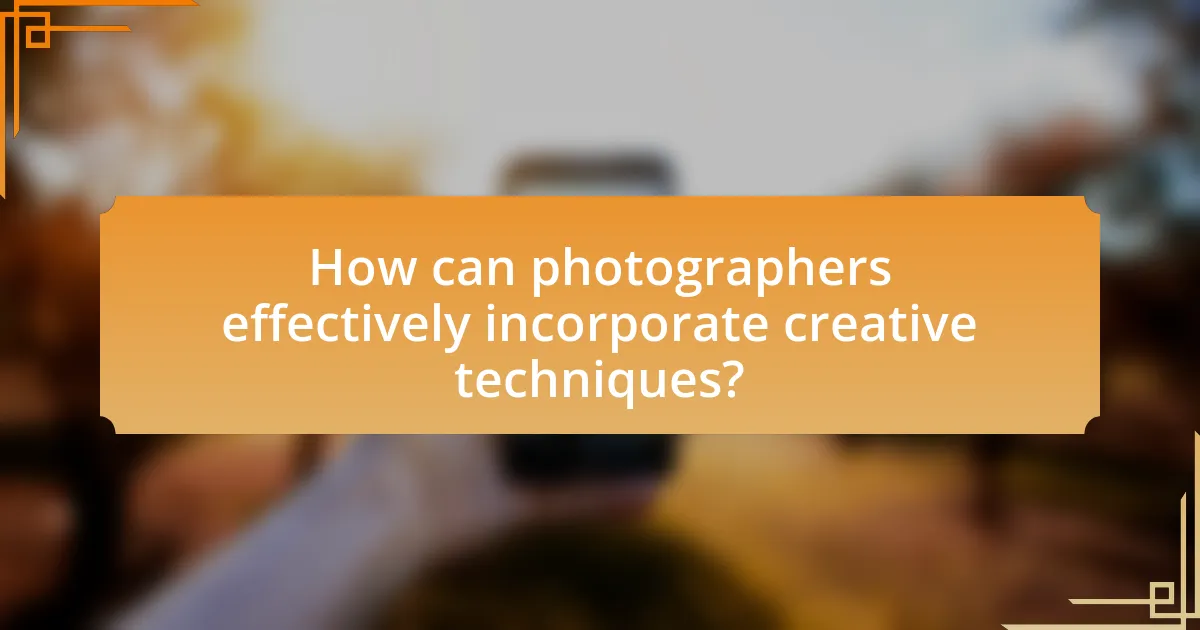
How can photographers effectively incorporate creative techniques?
Photographers can effectively incorporate creative techniques by experimenting with various angles, lighting, and composition methods. Utilizing unconventional perspectives, such as shooting from above or below the subject, can create unique visual narratives. Additionally, manipulating natural light or using artificial sources can enhance mood and depth in images. For instance, backlighting can produce a halo effect, adding a dreamy quality to wedding photos. Research indicates that diverse compositional techniques, such as the rule of thirds or leading lines, can significantly improve visual interest and engagement in photography.
What are some innovative techniques for capturing candid moments?
Innovative techniques for capturing candid moments include using a telephoto lens to maintain distance while still capturing intimate interactions, employing burst mode to increase the chances of getting the perfect shot, and utilizing natural light to enhance the authenticity of the moment. Telephoto lenses allow photographers to remain unobtrusive, which encourages genuine expressions. Burst mode captures multiple frames in quick succession, ensuring that fleeting moments are not missed. Natural light, especially during golden hour, adds warmth and depth to images, making them feel more organic and less staged. These techniques are widely recognized in the field of photography for their effectiveness in producing authentic and engaging images.
How can photographers use movement to create dynamic images?
Photographers can use movement to create dynamic images by incorporating techniques such as panning, motion blur, and capturing candid moments. Panning involves moving the camera in sync with a moving subject, resulting in a sharp subject against a blurred background, which conveys speed and action. Motion blur can be achieved by using slower shutter speeds, allowing the movement of subjects to create a sense of fluidity and energy in the image. Capturing candid moments during a wedding, where subjects are engaged in natural movement, adds spontaneity and emotion, enhancing the overall dynamism of the photograph. These techniques are supported by the fact that dynamic images often evoke stronger emotional responses, making them more memorable for viewers.
What role does framing play in enhancing artistic shots?
Framing plays a crucial role in enhancing artistic shots by guiding the viewer’s attention and creating a sense of depth and context. Effective framing can isolate the subject, emphasize important elements, and create a balanced composition, which is essential in artistic wedding photography. For instance, using natural elements like trees or architectural features as frames can add layers to the image, making it more visually engaging. Studies in visual perception indicate that well-framed images are more likely to evoke emotional responses, thereby increasing their artistic impact.
What are the best practices for planning an artistic wedding shoot?
The best practices for planning an artistic wedding shoot include thorough pre-shoot consultations, scouting locations, and creating a shot list. Pre-shoot consultations allow photographers to understand the couple’s vision and preferences, ensuring alignment with their artistic style. Scouting locations helps identify unique backdrops and lighting conditions that enhance creativity, while a shot list ensures that essential moments are captured without missing artistic opportunities. These practices are supported by the fact that successful wedding photographers often emphasize the importance of preparation in achieving artistic results, as noted in various photography workshops and industry publications.
How can couples collaborate with photographers to achieve their vision?
Couples can collaborate with photographers to achieve their vision by clearly communicating their preferences, sharing inspiration, and being open to creative suggestions. Effective communication ensures that photographers understand the couple’s desired style, themes, and specific shots they envision. Couples should provide examples of photographs they admire, which helps photographers grasp their aesthetic. Additionally, discussing the timeline and key moments during the event allows photographers to plan accordingly and capture essential memories. Research indicates that successful collaboration often leads to higher satisfaction with the final images, as seen in studies highlighting the importance of client-photographer communication in creative fields.
What should photographers consider when scouting locations for artistic shots?
Photographers should consider the lighting conditions, composition opportunities, and the emotional resonance of a location when scouting for artistic shots. Lighting is crucial as it affects the mood and quality of the images; for instance, golden hour provides soft, warm light that enhances subjects. Composition opportunities include unique angles, leading lines, and interesting backgrounds that can elevate the visual impact of the photograph. Additionally, the emotional resonance of a location can create a deeper connection in the images, making them more meaningful to the subjects and viewers. These factors collectively contribute to the overall effectiveness and artistry of wedding photography.
What tips can help photographers improve their artistic wedding photography skills?
To improve artistic wedding photography skills, photographers should focus on mastering composition, utilizing natural light, and experimenting with creative angles. Mastering composition involves understanding the rule of thirds and leading lines to create visually appealing images. Utilizing natural light enhances the mood and atmosphere of the photographs, as studies show that images taken in soft, natural light are often more flattering and emotionally resonant. Experimenting with creative angles, such as shooting from above or below, can add unique perspectives that differentiate a photographer’s work. These techniques are supported by the fact that many award-winning wedding photographers emphasize the importance of these elements in their portfolios.
How can continuous learning and practice enhance a photographer’s artistry?
Continuous learning and practice enhance a photographer’s artistry by expanding their technical skills and creative vision. As photographers engage in ongoing education, they learn new techniques, such as advanced lighting and composition, which directly improve their ability to capture unique and compelling images. Research indicates that deliberate practice, as outlined by psychologist Anders Ericsson, leads to mastery in any field, including photography. This mastery allows photographers to experiment with creative angles and techniques, ultimately resulting in a distinctive artistic style that resonates with viewers.
What resources are available for photographers to refine their techniques?
Photographers can refine their techniques through various resources such as online courses, workshops, photography books, and mentorship programs. Online platforms like MasterClass and Skillshare offer structured courses taught by professional photographers, covering topics from composition to lighting. Workshops provide hands-on experience and direct feedback from experts, while photography books, such as “Understanding Exposure” by Bryan Peterson, offer in-depth knowledge on technical aspects. Additionally, mentorship programs connect emerging photographers with seasoned professionals for personalized guidance, enhancing skill development through real-world experience.
